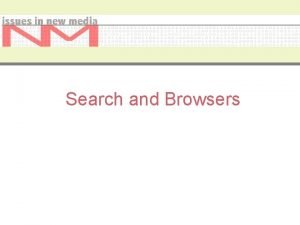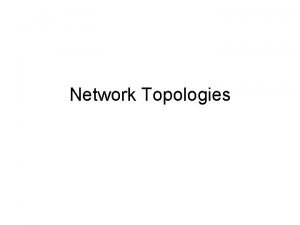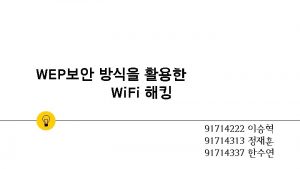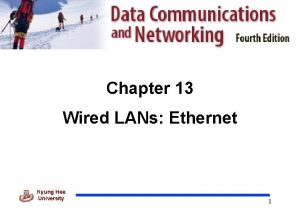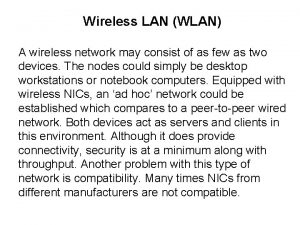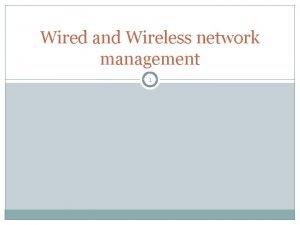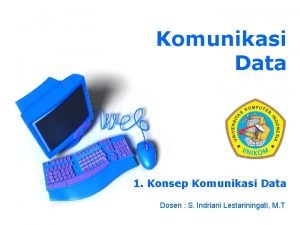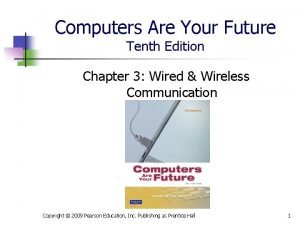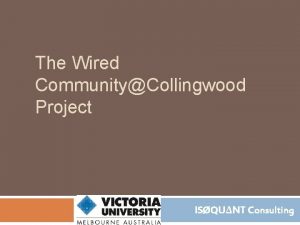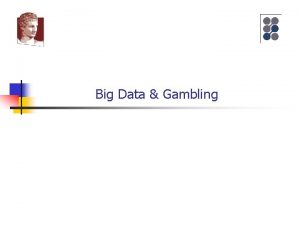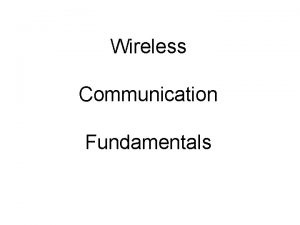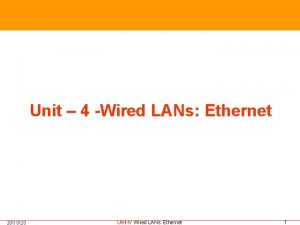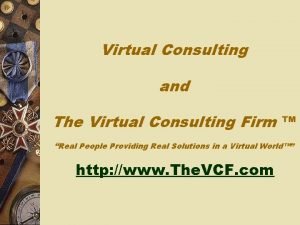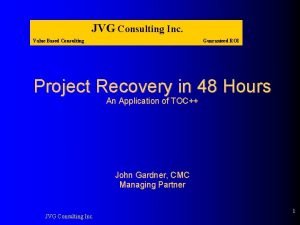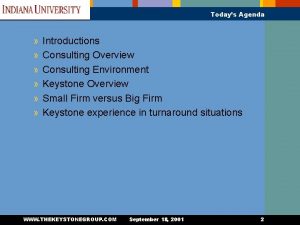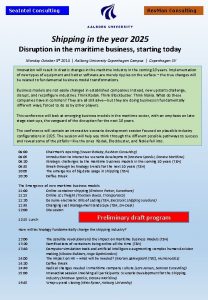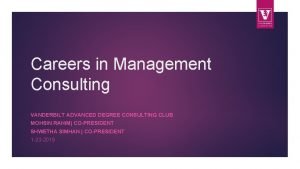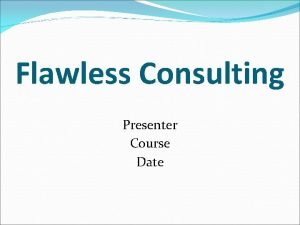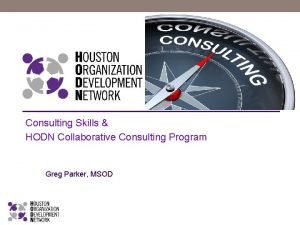The Wired CommunityCollingwood Project ISQUNT Consulting Wired CommunityCollingwood








































- Slides: 40

The Wired Community@Collingwood Project ISØQU∆NT Consulting

Wired Community@Collingwood Technology has made a difference to people’s lives. Increasingly it is an accepted part of job search techniques, employment, and educational success and more it is also a personal information tool. If you are isolated, suffer poor health, or do not speak English, then the Internet can improve your ability to communicate with family and friends, feel connected to your community and improve your health and wellbeing. ISØQU∆NT Consulting

The Evaluation This research was about an extraordinary project in the inner city of Melbourne. A partnership between a not-for-profit Agency called Infoxchange Australia that uses technology as a social justice tool. They partnered with some of the most disadvantaged people living on a public housing estate to provide them access to the internet and the result has been. . . life changing. ISØQU∆NT Consulting

Project Objectives The project objectives: improve the social and economic circumstances of the Collingwood Public Housing Estate; strengthen the capacity and cohesiveness of the community and its networks; and provide access to Information Communication Technology for those normally excluded from its benefits thereby increasing skills and access for Collingwood housing estate residents. ISØQU∆NT Consulting

There were lots of lessons. This was a very ambitious project! The project needed Government to partner, not just provide funds. The ICT infrastructure chosen was a challenge to get optimum delivery. Residents had to be engaged because in the absence of their own social capital, personal and associational networks, they required individual support to even get in the front door of the Wired Project Office. Some residents do not move outside a very restricted survival regime; reluctant to participate in new initiatives, for fear of further failure, lack of income and fragile mental health. ISØQU∆NT Consulting

Why an ICT project – because the Digital Divide is Real There is increasing evidence that the lack of access to information and communication technology (ICT) or the ‘digital divide’ severely limits education, employment and economic prospects. ISØQU∆NT Consulting

Context of the Digital Divide Research demonstrates that people on low incomes, without tertiary education, living in rural/remote areas, of Indigenous heritage, with disabilities, with a language background other than English and aged over 55. . . . can lack opportunities to access the internet; compounding their disadvantage. ISØQU∆NT Consulting

Digital Divide in Australia Notley and Foth (2008) noted on the access to internet stats: Indigenous Australians were 69 per cent less likely than non-Indigenous people to have any internet connection. People who were isolated by geography. Educational attainment influenced overall and broadband internet access. Income was considered the single largest determinant of internet access and broadband, with results showing that higher income increased the likelihood of a person having any internet connection. People with a disability: only 28 per cent of people requiring assistance with core activities had broadband access, in comparison with 48 per cent for people not needing assistance. Single parents with dependent children under 15 years had 77 per cent internet and 52 per cent broadband access compared with 92 per cent and 68 per cent respectively for comparable dual parent households (Notley et al, 2008). ISØQU∆NT Consulting

The Wired Community@Collingwood Project Outline The $3. 6 million Wired Community@Collingwood initiative is the largest project of its kind in Australia and includes $1. 9 million funding from the Victorian Government and $1. 7 million from in-kind and philanthropic contributions. The Wired Community@Collingwood project aims to provide communication, learning and employment opportunities through ICT to all Collingwood estate residents across approximately 950 dwellings. ISØQU∆NT Consulting

About Collingwood and Infoxchange The estate is a public housing estate located about three kilometers from the Central Business District of Melbourne and provides low cost housing to people with a low socio-economic profile and recent migrants and refugees. Infoxchange Australia, a not-for-profit community ICT provider with a mission focused on using technology for social justice, established the funding model and led the partnership based on the success of their demonstration project at Atherton Gardens. ISØQU∆NT Consulting

Focus of this Evaluation The prime purpose of the evaluation is to understand how individuals and the community at the Collingwood estate use ICT technologies and the impact it has on their lives in the areas of; education and training; community and culture; support and development of citizenship and democracy; health and well-being; economic equity, opportunity and sustainability; and information and communication. ISØQU∆NT Consulting

A Community Development Framework. The importance of developing a project implementation plan that is underpinned by community development principles was pivotal to this project and essential when working in this community. Developing partners in this project was critical to the evaluation and to the project. . . to secure the funding and implement the project. ISØQU∆NT Consulting

Framework of the Evaluation The evaluation has both development-facilitation and meritperformance assessment strands (Boyle, 2008) and placed high value on: Ongoing systematic engagement with key project stakeholders Evidence-based determination of the merit and worth of the intended outcomes; Capturing and assessing the value of significant unintended outcomes; Assessing the efficacy of processes; both project implementation and those developed as project outcomes; Supporting an information-driven reflective and improvement focused approach to project implementation and management; Learning and recording learning that will help to enhance ISØQU∆NT Consulting future project design and implementation.

Approach The research is underpinned by a participatory action research methodology to facilitate a transfer of skills and knowledge to the Wired Community@Collingwood project group. A collaborative approach to evaluation recognises that information and knowledge about people and communities resides within communities. Particularly important in an environment such as the Collingwood housing estate where there a series of programs and interventions and the causal relationships are difficult to disentangle. ISØQU∆NT Consulting

Evaluation Domains and Dimensions ISØQU∆NT Consulting

Methodology A multi-method approach was implemented including: Qualitative Analysis: incorporating both interviews and focus group sessions with residents and key stakeholders. Survey of residents: the surveys undertaken at two points in time (2009 and 2010) have a qualitative and quantitative dimension including; perceptions of self/community, citizenship, engagement, well-being and changes in skill, education, employment and unintended outcomes. A third survey of Infoxchange users was conducted in October 2010 to capture the impact of the service upgrade. ISØQU∆NT Consulting

Methodology Document analysis: implementation plans, progress reports and minutes of key program provider and related committees. Quantitative data analysis: a range of socioeconomic data provided by a range of service providers and other key government stakeholders. ISØQU∆NT Consulting

Collecting baseline data The baseline data was collected at the outset (2009 resident survey and other quantitative data supplied by service providers) to facilitate the comparative analysis at key project milestones for assessing outcomes and impact. The 2009 survey was undertaken by residents immediately following training and the post program survey was conducted in 2010 up to one year following the training. ISØQU∆NT Consulting

Good Research Takes Time This meant that the research team spent time on the estate building relationships. It takes time in the training rooms, time attending community events, time sitting and talking to people, time solving their ICT problems along side of them, time attending social groupings on the estate, time eating lunch with residents and time with children and parents. ISØQU∆NT Consulting

Ensuring Cultural Diversity The research team had access to the Infoxchange Australia data that identified who had done training, received a computer and preferred language. Three residents from the estate were employed that spoke the most dominant community languages, being Mandarin, Vietnamese and Arabic. They agreed that they were more successful because they could use their shared cultural connection between resident and research assistant as an engagement point. Their work provided the research with 60% of the resultant surveys. ISØQU∆NT Consulting

Reflecting on this Methodology It was important to be willing to sit with people, which also meant talking about their children and their life on the estate. You (the Anglo-Saxon research team member) would never have got in the door; it was because I am young and African, I look like them and I am Muslim - that is why they let me in. It took one hour with each person; not only listening to them but interpreting the survey. It was also important to assure them that the survey was confidential. I told them about the prizes and they would smile, but I know that would not normally motivate them to do the ISØQU∆NT Consulting

Lessons and Findings Partnering with Govt – A project challenge The nature of the contract between the infrastructure providers, Infoxchange and the Cabling contractor and Government is a seemingly intractable problem facing community programs. On the one hand success would be optimised by a partnership whereby Government did not operate as a contract manager but as a partner. On the other hand Government requires accountability for the delivery of public services using public funds. Both positions are credible, however, the result impacted on project implementation and the achievement of intended project outcomes. ISØQU∆NT Consulting

The lack of partnership was a barrier Working with a wiring contractor meant resolution was always difficult and time consuming. They would have a schedule of response time; often leaving residents with no internet for several days at a time. The process of accountability in this case highlights one aspect of the program governance challenges that were not built as a partnership but as a contractor and contract manager set of processes. ISØQU∆NT Consulting

Price Sensitivity Service reliability and the speed at which the internet operated was a project challenge. It is underpinned by price sensitivity, the project needed more establishment funds – in the absence of that it meant it was reliant on building a customer base at $15 per month to buy bandwidth. For the first year of the project the issues of contractors and bandwidth were tricky. ISØQU∆NT Consulting

The Critical Component The social enterprise place based model that employed local residents in the Hub. They were bi-lingual, answered questions, went into peoples homes and fixed their computers and overall. . . It provided a base for the research team. Built trust in the project. ISØQU∆NT Consulting

Survey Highlights Around 54% of resident respondents to the 2009 survey were using computers for the first time as part of the project. This is a significant outcome in bridging the digital divide considering that around 80% of Australians were using the internet in 2009. ISØQU∆NT Consulting

E-Inclusion Intensity of use is an indicator of e-inclusion and can be measured by the percentage of individuals who access the internet every day (or nearly every day) or every week (Bentivegna and Guerrieri, 2010). Survey results reveal the following intensity of usage patterns across several activities: ISØQU∆NT Consulting

Utilising the Net Access to news and current affairs is the most frequent daily activity with 29. 3% of residents reading or listening to online news “daily or almost every day”, with a further 18. 3% accessing news on a weekly basis (around 5 in 10 overall). Using email is the next most frequent use of the internet with 25. 3% of residents using email daily, with a further 20. 5% using email every week. 19% use social networking media (Facebook, Skype, Myspace etc. ) as another form of communication each day, with a further 14% using social media each week. Study or research is the next most significant activity with around 18% and 12% using the internet for this purpose on a daily and weekly basis respectively. Using the internet for entertainment is the next most frequent activity for 16. 1% of residents, with a further 23. 9% using it for entertainment on a. Consulting weekly basis. ISØQU∆NT

Increasing Employment Access 50% of those unemployed used the internet for employment search, with 37. 5% of those looking for work online on a weekly basis. Even those who were employed were using the internet for employment search, with almost 70% of those employed on a part-time basis using the internet to look for jobs. ISØQU∆NT Consulting

Connecting to the World Of particular interest is the impact of this ICT initiative on resident behaviour and capability. Residents were presented with a series of capability statements and asked to indicate the extent to which access to ICT had impacted on these. The results are summarised as follows: Around 50% of respondents to the 2009 and 2010 surveys report a significant (19. 8%) or moderate (30. 5%) change in their ability to stay in touch with friends and family. Around 42% of residents report a significant (16. 5%) or moderate (25. 6%) change in their ability to learn new ISØQU∆NT Consulting

Improving Well-Being Around 6 in 10 residents report some improvement in their sense of well-being attributable to the provision of ICT with 7. 3% and 29. 4% reporting significant and moderate change respectively. A similar proportion (6 in 10) residents report a change in their access to news and information with 8. 1% and 37. 8% reporting a significant and moderate change respectively. ISØQU∆NT Consulting

Case Studies What is evident from this evaluation is how the Wired Community@Collingwood project has benefited residents and the significant impact of these benefits for many residents. It may be Jack talking about getting new recipes from the internet or buying DVD’s from Ebay, Anita articulating how important the internet was to her recovery from cancer Joan speaking about her passion for the Chinese opera and how happy she is that she can now stream the opera to her flat in Collingwood. The internet had made a difference to their lives by improving their connection to these things. ISØQU∆NT Consulting

Key Themes Improving health and well-being The discussion with participants about an improvement to health and well-being was a little surprising, foremost for the fact that participants themselves made the connection. I play the accordion in Fitzroy. In China my husband was a director of music. It has been our life and still important to me. I like doing it and it is good for the mind. The computer keeps my mind active. I got a typing program from the internet because I wanted to learn how to type better on the computer. The computer has been fantastic, because I am so isolated, I have problems leaving my apartment. But I don’t go to the clinic as often now as I think I feel better just being more active, even if it is in my flat. I use email – I send my friends emails and photos. It helps me feel connected. ISØQU∆NT I Consulting love the computer because I am lonely. And it’s really a window

Education and Training I use my computer for searching for a job and that is how I got the job that I have now at the City of Yarra. More things I would like to learn on the computer so I need to be able to do my own essays on the computer and know how to print it and save it. Before if I was looking for a job I have to send my resume through the post. Now I can send on the email. It is very easy! I feel very happy about it. I know that the computer is very important for me, for work. I have friends who like the computer because they study so far away and they used to have to go to the school library after school but then when they left to come home it was a bit dark. ISØQU∆NT Consulting

Community and Culture I do use that (the Collingwood intranet site) I like to see the weather. The internet is important for my son for school etc. it’s good for him to check his football club site to make sure nothing has been changed. I was also able to look up about my heritage which is wonderful, and I can just get on to MSN, what the latest goss, you know I love to read about Posh and Becks and all those celebrities. I always read the local Collingwood information. It just makes you feel like you have a community – you know with things happening and it even has its own space on the web. ISØQU∆NT Consulting

Communication - Connection to the World I email my home and I send photos back home and I use the webcam. I talk to my children’s school as well, so I email my daughters teacher and then he will email me back if I have any question or just need to talk to him. I also read news from home. I also talk to my brother on MSN because he is in USA. I also use the computer as a music player. I use the email to contact my brother and my mate. ISØQU∆NT Consulting

Communication - Connection to the World (cont. ) I read the news on the internet as well. I read the world news, I was interested in the Italian Prime Minister yesterday. I read about politics, all the stuff about Iraq, how Britain is pulling out and leaving it all up to the Americans, I think Australia needs to pull out now, I just go in there every day and have a look. I wrote a lot of letters to politicians, I have handwritten a lot of letters in the past, after 9/11 after the US invaded Iraq, I wrote a thesis, about 20 or 30 pages long, on my perceptions, I sent one to John Howard, Tony Blair, Condalesa Rice, George Bush – I got three letters back from John Howard’s office - one from Senator Heffner, and 2 from John Howard’s Office. ISØQU∆NT Consulting

Conclusions One of the key learnings for this project is the importance of partnership, collaboration and organisational management. Where there has been an absence of these elements they have been identified as barriers to the projects successful implementation. To support change in communities that are faced with long term disadvantage it will require Government to consider how they do business. ISØQU∆NT Consulting

Being on the wrong side of the digital divide in the twenty first century disconnects you from a part of a world that many take for granted. At Collingwood these participants are making those connections on a daily basis and are excited about the new possibilities of being a part of the available technology. ISØQU∆NT Consulting

Contact Info Associate Professor Theo Papadopoulos Theo@isoquant. com. au Associate Professor Robyn Broadbent Robyn. Broadbent@vu. edu. au ISØQU∆NT Consulting
 Steven levy wired
Steven levy wired Wired topology
Wired topology Wired and wireless media
Wired and wireless media 06 91714313
06 91714313 Seam in sheet metal
Seam in sheet metal Wired lans ethernet
Wired lans ethernet What does a wireless lan (wlan) act as to a wired network?
What does a wireless lan (wlan) act as to a wired network? Wired vs wireless broadband
Wired vs wireless broadband Batteries in parallel vs series
Batteries in parallel vs series Understanding wired and wireless networks
Understanding wired and wireless networks Kepanjangan dari utp pada media wired adalah
Kepanjangan dari utp pada media wired adalah Tenth chapter wired
Tenth chapter wired Unicast
Unicast Hình ảnh bộ gõ cơ thể búng tay
Hình ảnh bộ gõ cơ thể búng tay Ng-html
Ng-html Bổ thể
Bổ thể Tỉ lệ cơ thể trẻ em
Tỉ lệ cơ thể trẻ em Chó sói
Chó sói Tư thế worms-breton
Tư thế worms-breton Bài hát chúa yêu trần thế alleluia
Bài hát chúa yêu trần thế alleluia Môn thể thao bắt đầu bằng từ chạy
Môn thể thao bắt đầu bằng từ chạy Thế nào là hệ số cao nhất
Thế nào là hệ số cao nhất Các châu lục và đại dương trên thế giới
Các châu lục và đại dương trên thế giới Công thức tiính động năng
Công thức tiính động năng Trời xanh đây là của chúng ta thể thơ
Trời xanh đây là của chúng ta thể thơ Mật thư tọa độ 5x5
Mật thư tọa độ 5x5 Làm thế nào để 102-1=99
Làm thế nào để 102-1=99 Phản ứng thế ankan
Phản ứng thế ankan Các châu lục và đại dương trên thế giới
Các châu lục và đại dương trên thế giới Thể thơ truyền thống
Thể thơ truyền thống Quá trình desamine hóa có thể tạo ra
Quá trình desamine hóa có thể tạo ra Một số thể thơ truyền thống
Một số thể thơ truyền thống Cái miệng xinh xinh thế chỉ nói điều hay thôi
Cái miệng xinh xinh thế chỉ nói điều hay thôi Vẽ hình chiếu vuông góc của vật thể sau
Vẽ hình chiếu vuông góc của vật thể sau Nguyên nhân của sự mỏi cơ sinh 8
Nguyên nhân của sự mỏi cơ sinh 8 đặc điểm cơ thể của người tối cổ
đặc điểm cơ thể của người tối cổ Thế nào là giọng cùng tên
Thế nào là giọng cùng tên Vẽ hình chiếu đứng bằng cạnh của vật thể
Vẽ hình chiếu đứng bằng cạnh của vật thể Phối cảnh
Phối cảnh Thẻ vin
Thẻ vin đại từ thay thế
đại từ thay thế
